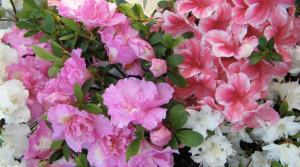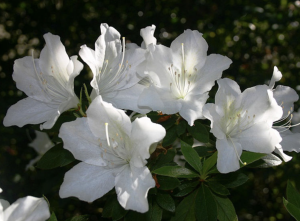When it comes to flowering shrubs, it’s difficult not to be stopped in your tracks by the ravishing beauty of an Azalea in full bloom.
Azaleas are one of the most striking of flowering shrubs for any garden, yet have attracted a rather unfair reputation of being “fussy” or difficult to grow.

With drought conditions experienced over recent times in many parts of Australia, azaleas have been somewhat overlooked as being able to withstand difficult times. Yet with a small amount of understanding, azaleas can become an amazing, colourful and drought hardy addition to any garden, patio or courtyard space.
Most modern hybrid azaleas relish a partly shaded site in the garden while some older varieties simply prefer the full sun for strong flowering. Yet they all have only a few common requests that should be addressed.
Soils for Azaleas
Although all plants will be happiest in a neutral pH zone (6-7), all azaleas enjoy a compost enriched soil that is slightly on the acidic side of the pH scale (5.5).
If you have a pH test kit, it’s essential that you take a reading to indicate if the location will be appropriate. Be guided by some of the other plants in your garden as they can be indicators if the location is suitable. For instance, if you have roses, rosemary, olives or lavender doing well in your chosen area, then most likely the pH will be a little more alkaline and azaleas may struggle to become fully established. Species such as camellias, gardenias, ixora, brunsfelsia, magnolia and tibouchina will naturally indicate acid soil conditions and the chances of azaleas doing well amongst them are far greater. Nevertheless, if you’re unsure, pop into Wingham Nursery with a small soil sample and we can test the pH for you.
Establishment
Azaleas have quite slow-growing, fine root systems and can often take several months to become fully established in the garden. While young, they are not strong competitors with neighbouring trees and shrubs for soil moisture and are easily robbed of this vital resource. To help with this, consider using (hydrated) water storing crystals at the base of the planting hole. Deep watering should be done at least three times a week during warm weather and once a week during the winter months. The addition of a Liquid Seaweed at time of planting and again at three-week intervals will encourage strong root development and alleviate transplant shock.
To lock in moisture, especially with high summer temperatures, always remember to mulch the surface of the soil. Tea tree or red cypress mulch looks very much at home with azaleas and all woodland shrubs, but fine-grade sugar cane will also suffice. Allowing a generous establishment period for azaleas will undoubtedly be the most important step anyone can take in ensuring strong, healthy plants able to withstand drought periods when older.
Azalea varieties and correct positions for planting
Varieties such as (azalea indica) cv: Alba Magnifica (white), cv: Exquisite (mid pink), cv: Magnifica (magenta),and cv: Alphonse Anderson (light pink) are total sun-lovers and enjoy being out in the open, exposed to full sun and climatic conditions. These forms are most commonly seen in older style gardens and can reach substantial heights of over two metres in the garden and should be granted the space to fully develop. If you take the time to place your nose close to the blooms, you will also be surprised at the delightful perfume that they exude which is something that most garden azaleas are not associated with. If space is limited, these taller “sun tolerant” forms can be easily pruned to shape to fit in with most spaces.
Some strong cultivars such as cv: Red wings and the miniature flowering Kurume forms such as cv: Kirin (light pink), are happy in both sun and shaded sites. The Kurume forms are striking by their prolific flowering of smaller size that seem to completely smother the entire plant. Red wings carries the added advantage of spot flowering throughout the entire year and is highly regarded as one of the very best flowering azaleas in most countries.
Without a doubt, it’s high time that all azaleas deserve a strong revival and allow them to bring vibrant colour, texture and most importantly, longevity to all of our gardens.

Azaleas in pots
If space is at a premium in your garden, then consider getting the most from your azaleas by growing them in pots. Searles Azalea & Camellia Mix is a perfect choice for all potted azaleas as it is specifically designed for all acid loving plants. Make sure to choose a glazed pot as your choice as this will reduce moisture loss from the sides and also reduce lime, (which is alkaline) from seeping into the mix over time.
Azalea Pests & Diseases
Contrary to popular belief, azaleas aren’t plagued by a long list of concerns that other plant species such as roses seem to attract.
The biggest and most common problems that azaleas seem to battle are from sap-sucking insects such as mites and azalea lacewing. They are easily spotted when the foliage turns from bright green to a mottled, silver patterning on the leaves. If left uncontrolled for several years they can certainly weaken the plant and prevent them from producing enough chlorophyll to naturally sustain their health and growth. Both can easily be controlled by using Searles Conguard and Wettable Sulphur when the plants aren’t in flower.
The major fungal problem associated with azaleas is petal blight. This is primarily caused by excessive moisture in and around the plants while in full bloom. This is evident from the rapid browning of the flowers turning them slimy and limp while remaining on the plant and will affect the entire plant and any (possible) neighbouring azaleas. The sun tolerant forms (as mentioned earlier) seem to have much greater tolerance to this disease and are rarely affected. Spraying a trusted fungicide such as Searles Mancozeb Plus in the weeks prior to flowering will control this outbreak. Removal of all fallen foliage and flowers around the base of the plant is also highly advised as the spores of the fungal problem can remain viable in the surrounding soil. Petal blight is mostly witnessed in regions with high rainfall levels during the spring flowering season.
We have a huge selection of azaleas at the nursery, all of which we grow on site; so you know that they’ll thrive in the local area. Best of all, they’re loaded with flower to help with your choice, or simply admire on a stroll through the nursery.
Wingham Nursery & Florist
Find us on Facebook
02 65534570
